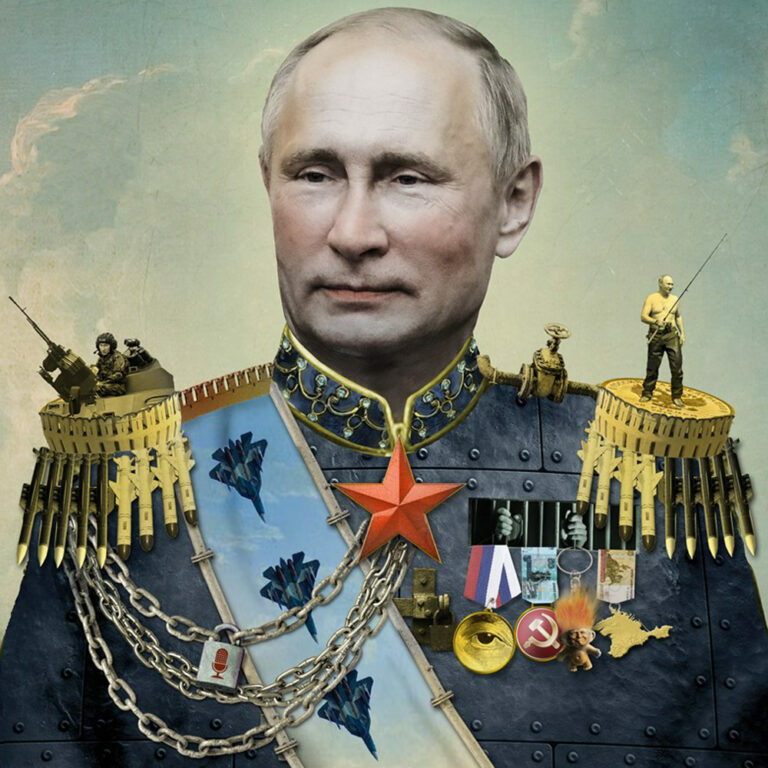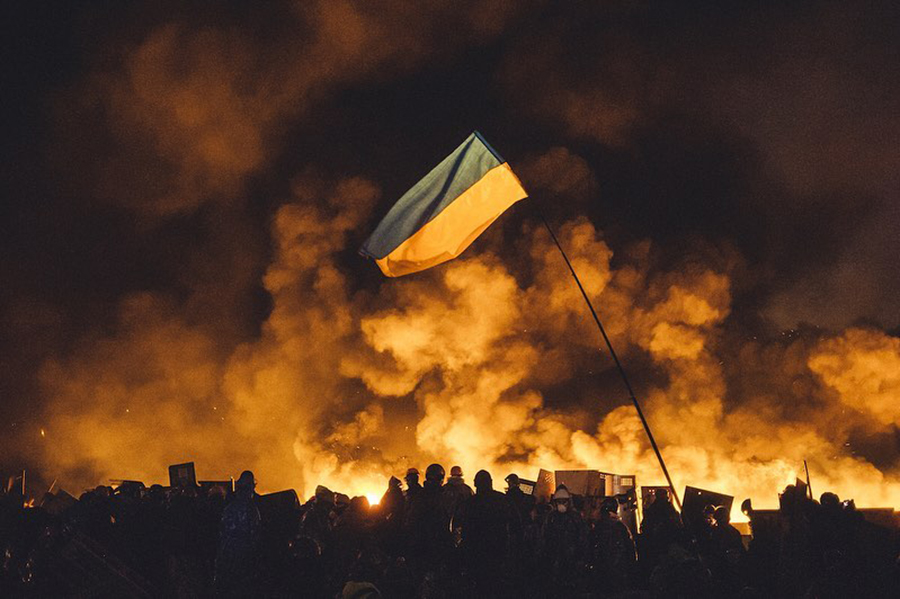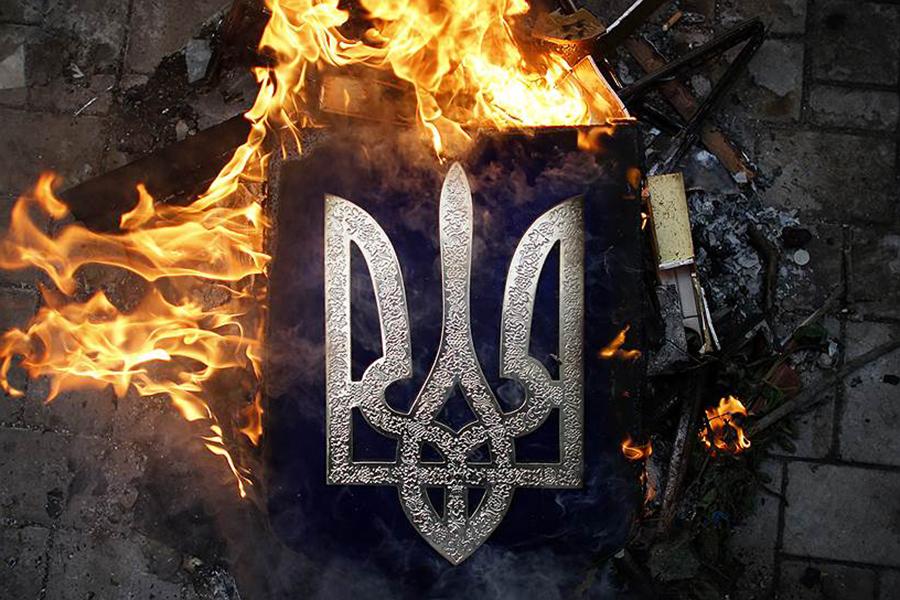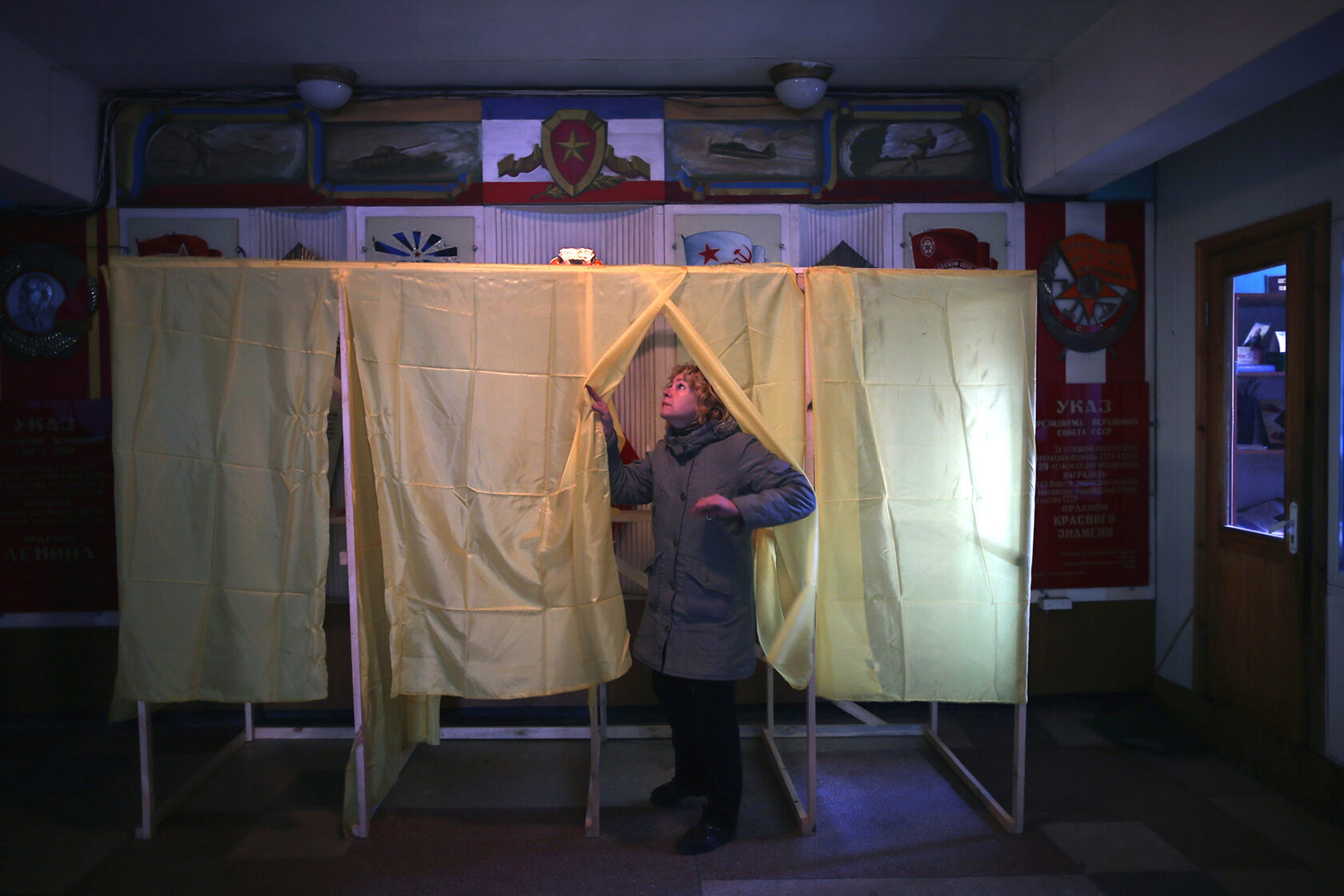
The Russian Federation has been occupying parts of other independent countries for many years. Since the collapse of the USSR, it has participated in the creation of such unrecognized and self-proclaimed entities as the “Pridnestrovian Moldavian Republic” (a legal part of Moldova), the “Republic of Abkhazia” (a legal territory within Georgia), the “Republic of South Ossetia” (the Tskhinvali region of Georgia), “Luhansk People’s Republic” and “Donetsk People’s Republic” (legal territories of Ukraine), the “Republic of Crimea” (also created on temporarily occupied Ukrainian territory).
The aggressor country uses the same methods it inherited from Bolshevik Russia and the Soviet Union to seize more land. It claims to liberate, protect or unify territories, but the result is always the same — the occupied entities cease to develop, become almost completely isolated from the world, and decline economically.
During the full-scale invasion of Ukraine, the Russian Federation uses the same playbook, conducts a hybrid war, and puts the wool over its citizens’ eyes with informational propaganda. Let’s take a closer look at the tools Russia uses to satisfy its imperial greed.
Invasion of another state for the purpose of “protecting the rights” of the Russian-speaking population
Moldova

After the collapse of the USSR, the Pridnestrovian Moldavian Republic (also known as Transnistria) emerged on the territory of independent Moldova as a self-proclaimed state. Since 1956, the Russian 14th Army was stationed on its territory and guarded weapons and ammunition warehouses. In 1992, under the command of Russian General Oleksandr Lebed, together with separatist groups, the army came into a conflict with independent Moldova. In a while, this conflict turned into the Transnistrian War.
According to Russia, one of the reasons for the clash was the alleged “language problem”, namely the law of the Republic of Moldova on the State Language, which recognized Moldovan as the only state language. Lack of knowledge of the state language could be a reason for dismissal from state positions, for example. It is important to note that the law did not prohibit speaking Russian, it rather consolidated Moldovan as official language in the independent state of Moldova. However, the Russian-speaking population refused to learn and speak the Moldovan language and use it in public spheres, claiming that such a law was discriminatory. They tried to appeal with the argument that “everyone knows Russian anyways”. However, people in Moldova knew Russian because of years of active russification under the USSR, just like in other Soviet republics that had thair native language repressed in favour of Russian.
The Moldovan language
One of the two names of the Romanian language in the Republic of Moldova.
Russian media still presents the rhetoric about discrimination of Russian speakers in Moldova. After the start of the full-scale invasion of Ukraine, the deputy commander of the Central Military District of Russia, Major General Rustam Minnekayev, said, that control over the south of Ukraine is another way out to Transnistria, where the Russian-speaking population is allegedly still being oppressed.
Georgia

The Russians acted in Georgia according to the same scenario. After the collapse of the USSR, such parts of the former Georgian SSR as Abkhazia and South Ossetia, heavily backed by Russia, declared their independence. In response to these actions, Georgian government sent troops to keep these territories within the state. There, they were met by armed separatist groups and Russian and Chechen mercenaries.

Russia claimed that it maintained neutrality in this conflict, but its special services helped the Abkhaz separatists with troops and equipment. Active hostilities lasted from 1991 to 1993 and ended with Russian control over the self-proclaimed states within Georgia.
In 2008, the Russian-Georgian war started. On August 8, Russian forces began the invasion of Georgia, but already outside the borders of the unrecognized republics. They called their actions an “operation of forcing Georgia to peace.” The fighting lasted until August 12 and ended with the defeat of Georgian troops. Russia stated, that its actions were a forced response to the killing of Russian peacekeepers and Russian citizens living on the territory of South Ossetia. Attacks on peacekeepers from Russia have not been recorded or confirmed by any international organizations, including Human Rights Watch and IIFFMCG (Independent International Fact Finding Mission on the Conflict in Georgia).
Chechnya

After the collapse of the USSR, Chechnya (a republic in the north of the Caucasus region) declared its independence. In August 1991, Chechen politician Dzhokhar Dudayev overthrew the local communist government and created an anti-Russian autocratic state, the Chechen Republic of Ichkeria. The Russian government didn’t like such actions and aspirations for autonomy since it believed that the Chechen Republic was part of the Russian Federation.

In 1994, the armed forces of the Russian army began an offensive on the state’s capital, Grozny. The war lasted two years but ended with Russia’s defeat and the Khasavyurt peace treaty signed in 1996.
The Chechen Republic maintained its de facto independence until 1999. On September 23, then president of the Russian Federation, Boris Yeltsin, signed a decree “On measures to increase the effectiveness of counter-terrorist operations in the territory of the North Caucasus region of the Russian Federation.” In September, Russia invaded Chechnya for the second time and declared its actions a “counter-terrorist operation”.

Vladimir Putin, who assumed the post of president in January 2000, said, that the Russian military is protecting the Chechen people from the criminals and terrorists who commit terrible crimes in Chechnya.
Ukraine

Photo: Maksym Dondyuk
At the final stage of the Revolution of Dignity in Ukraine in 2014, without insignia, Russian soldiers invaded the territory of Crimea and seized government buildings. They also set up checkpoints along the strip connecting the peninsula to mainland Ukraine and took control of two Crimean airports, effectively cutting off Crimea from the rest of the country.
The Revolution of Dignity
Mass protests by Ukrainians began in 2013 and ended in the winter of 2014 with the overthrow of Yanukovych’s regime.
Putin explained his actions as the intention to protect the territory of Crimea and the people who live there from Ukrainian nationalists. The President of the Russian Federation also added that the situation in Ukraine had developed in such a way that they were simply “forced to start work on the return of Crimea to Russia”.

Photo: Marko Djurica for Reuters.
The same situation was in the east of Ukraine, in some areas of the Donetsk and Luhansk regions. Russia called the presence of its troops in this territory “a forced measure to defend the interests of the Russian-speaking population living in Donbas”.
With the start of Russia’s full-scale invasion of Ukraine on February 24, 2022, Russian rhetoric has not changed. Putin has stated that the so-called “special operation” aims to protect the Russian-speaking population of Ukraine, which is allegedly constantly oppressed. In addition, the president and other Russian statesmen and propagandists claim that “drug addicts, neo-Nazis, and nationalists have seized power in Ukraine”.
Violation of international law

Russia lies not only in its public statements but also in official agreements. The aggressor country repeatedly committed war crimes and violated international laws and human rights.

During the war in Georgia, Russian forces carried out aerial bombardment and artillery attacks, including on schools and hospitals, used cluster munitions, shelled, looted, and raped the civilian population. After the war’s end in August 2008, Russia and Georgia signed an EU-brokered deal that obliged each side to cease hostilities and withdraw its armed forces to pre-war positions. However, the Russian Federation did not comply with the agreements and continued to increase its military presence in illegal entities (“Abkhazia” and “South Ossetia”).

After the occupation of the city of Grozny and other regions of Chechnya, the behavior of Russian troops towards the civilian population remained cruel and corrupt. Russian forces carried out arrests and illegal detentions, shelled populated areas, tortured and killed civilians. They arrested people under false pretenses, interrogated, beat them, and sometimes threw them into pits and demanded bribes from their relatives.
In 1999, at the OSCE summit, Russian government finally agreed to withdraw troops from Transnistria. The agreements were recorded in the declaration of the Istanbul summit, but as a result, Russia did not fulfill its obligations.

By occupying Crimea in 2014, Russia violated 487 agreements with Ukraine, including 407 bilateral and 80 international ones. Russia violated the territorial integrity and sovereignty of Ukraine once again when it sent its troops into the territory of Donetsk and Luhansk regions. In addition, since the beginning of the war in the East, Ukraine has repeatedly concluded ceasefire agreements with Russia, but the aggressor country has constantly been violating them. And by recognizing the independence of the so-called “DPR” and “LPR” on February 22, 2022, Russia violated the Minsk agreements.
After the full-scale invasion of Ukraine, the number of allegations of crimes committed by Russia has increased significantly. Russian military personnel kills, tortures, and rapes civilians; creates humanitarian disasters; shoots journalists, doctors, and priests; tortures prisoners of war; uses prohibited weapons, and destroys and steals Ukraine’s cultural heritage.
Pseudo-referendums

Another method of Russian occupation is organization of illegal referendums on the territory of quasi-entities.
From December 1989 to November 1990, Transnistria held a referendum on forming the Moldavian Soviet Socialist Republic. It was allegedly attended by 79% of the population of the territory, and 95.8% voted for it. However, international organizations such as the Council of Europe, the EU, and the OSCE recognized the referendum as illegal, and all UN member states consider Transnistria a legal part of the Republic of Moldova. Russia itself did not recognize the sovereignty of the Transnistrian Moldavian Republic. At the same time, a certain coalition and informal association, called the Commonwealth of Unrecognized States (CIS-2), emerged between the quasi-formations occupied by Russia. It includes so-called Abkhazia, the Nagorno-Karabakh Republic (an unrecognized state in the South Caucasus), Gagauzia (an autonomous territorial entity within Moldova), the Transnistrian Moldavian Republic, and South Ossetia.

The same referendums were held in Georgia (“South Ossetia” in 1992 and 2006, “Republic of Abkhazia” in 1999). Russia helped to falsify the voting results, which are still not recognized internationally. On March 30, 2022, South Ossetia announcedthat it plans to organize a referendum on joining Russia by the end of this year.
In 2014, pseudo-referendums were held in Crimea and the Donetsk and Luhansk regions. The so-called “manifestation of the will” took place with violations. The UN, CIS, EU, and OSCE could not send their official observers, lists of voters were missing in certain cities, ballots were issued to anyone willing to vote, the turnout at the polling station was inflated. In addition, the Constitution and legislation of Ukraine provide for a change in the country’s territorial structure only through an all-Ukrainian referendum.

Photo: Dan Kitwood for Getty Images.
During the full-scale invasion of Ukraine, Russians are using identical methods and are planning to hold referendums in the recently captured territories of Tavria, Pryazovia, Podniprovia, and Zaporizhzhia and even in completely destroyed Mariupol. Russia prepares campaign materials and collects people’s personal information during the distribution of humanitarian aid to falsify the results. In addition, it searches for collaborators in the occupied territories in advance and appoints them to leadership positions to create an image of new local authorities.
Distribution of national IDs and ruble circulation

After holding referendums in the territories occupied by the Russian Federation, Russia starts handing out Russian national IDs. In this way, the occupying country emphasizes its control over these regions.
As of 2014, about 200,000 residents of the so-called Transnistrian Moldavian Republic have Russian national IDs (the total population for 2020 is 465,000 people). In the occupied territories of Georgia, the mass issuance of Russian national IDs began in 2002 after adopting a law, according to which former residents of the USSR could exchange their Soviet passports for Russian ones. In 2021, Putin signed a draft agreement with South Ossetia on dual citizenship and simplified acquisition of Russian citizenship. Also, after Russia recognized the independence of the self-proclaimed “Abkhazia” and “South Ossetia” and the occupation administration of both entities in 2008, treaties of friendship were concluded. The document provides that the Russian Federation will take effective measures to support and function the financial system of the republics since the means of payment in their territories is the Russian ruble.

The presence of people with Russian national IDs in the occupied territories is also one of the arguments Russian government uses to justify its aggression. Thus, in 2019, Putin signed a decree on simplifying the procedure for issuing passports to residents of the so-called “DPR” and “LPR”. Over 3 years, about 720,000 people received Russian documents under the accelerated procedure.
However, not all residents change their passports voluntarily. After the annexation of Crimea, 2.5 million people underwent forced passporting. In the same way, the inhabitants of the peninsula were forced to switch to the Russian currency, which got into circulation already in March 2014, literally a week after the pseudo-referendum.

Planting Russian currency is another occupation method that creates dependence on Russia and cuts off all routes to the native country. Also, since the beginning of the full-scale invasion, Russia has been trying to introduce the ruble in the occupied territories of southern Ukraine.
Identity destruction

In the occupied territories, Russia oppresses the ethnic population and sets its cultural space.
After the declaration of independence, Moldova abandoned using the Moldovan language with the Cyrillic writing system. Instead, it adopted the official Romanian language with its natural Latin alphabet. However, in Transnistria, three languages have been identified as official — Moldovan with Cyrillic, Ukrainian, and Russian. Despite this diversity, the curriculum in the self-proclaimed state is 90% based on Russian, and Romanian language schools are called “foreign”.
Ethnic Georgians living in occupied Abkhazia also have limited access to education in their native language. Back in the 1990s, the curriculum was written in Georgian in almost all schools in the region. Since 1995, the Abkhaz occupation administration has introduced Russian as the main language of education. This created obstacles to getting an education since most school-aged children did not speak Russian at all.
Russia also pursues a policy of destroying the ethnic self-awareness of its citizens in Crimea. Even during the times of the USSR, the native inhabitants of the peninsula, the Crimean Tatars, experienced mass deportation. Currently, Russia uses methods of settler colonialism by artificially resettling its citizens to Crimea and forcibly evicting citizens of Ukraine who have not received a Russian passport from the peninsula. Since the Russian occupation, many ethnicity-based crimes have been confirmed– the authorities persecute, kidnap, illegally detain and torture Crimean Tatars.

In addition, the occupiers are trying to form a Russian militarized identity in the minds of Crimean youth promoting “a bright future” in the army or the FSB. Educational activities are created following the decrees of the Ministry of Defense of the Russian Federation.
Since the beginning of 2017, the special fund “Russian Center” has started its activities in the occupied territories of Crimea and Luhansk and Donetsk regions The organization carried out “integration” measures, tried to implement Russian education standards, distorted historical facts, and sent children to militaristic patriotic camps. In the summer of 2020, the previously bilingual self-proclaimed “DPR” and “LPR” announced Russian as the only official language.

Russians are using these same methods during the full-scale invasion of Ukraine. Some schools are forced to switch to a Russian-language program in the temporarily occupied territories of southern Ukraine. The occupiers are conducting propaganda events, changing Ukrainian signs to Russian ones, re-erecting monuments of Lenin, and destroying textbooks on the history of Ukraine.
Dependency creation

A common feature for all analyzed quasi-states is Russia’s support in the foreign policy direction and economic absorption. For example, today, Russia is the largest trading partner of Abkhazia and almost the only partner for South Ossetia. According to a report by the International Crisis Group, 80% of all consumer goods in Abkhazia are imported from Russia. Another study shows that 64% of Abkhazian imports (mostly fuel and food) in 2011 were from Russia.
Russia’s economic activity in the Republic of Abkhazia is not limited to trade. In recent years, major local financial and infrastructure assets have been transferred to Russian ownership or control. In various aspects, the Abkhazian economy is gradually integrating with the Russian one. The situation is similar in Transnistria: some Russian politicians invest in the PMR industry, and many Transnistrian firms are owned by Russian companies. The foreign economic relations of the self-proclaimed republic are complicated by international non-recognition, and the leading trading partner is Russia.

As a result of this dependence on the Russian Federation, the new states begin to decline. Thus, in Crimea, in the first three months after the occupation, the export rate fell 19.9 times, and the import rate fell 15.5 times. In the occupied territories of Donetsk and Luhansk regions, a year after the occupation, the economy was approximately 20-50% of its previous level. We see a similar situation during Russia’s full-scale war against Ukraine. The economy in the temporarily occupied territories of the east and south is suspended, and the farmers there are forced to simply throw away the goods they grow with their own hands because there is no one to sell them to.
Isolation of independent sources of information and propaganda

Distributing propaganda and blocking access to information is a lever of influence on the people and a tool of information warfare. That’s why the main news sources in the occupied territories are Russian TV programs.
For example, in Abkhazia, there is almost no access to Georgian television, and the local mass media is completely controlled by the Russian authorities. In South Ossetia, the mass media are almost inactive except for the state broadcaster and news agency, which broadcast news mainly in Russian. The most common news channels here are Moscow TV and radio.
In Transnistria, Moldovan channels are blocked. There are also known cases when the occupational administration persecuted independent newspapers and journalists of the self-proclaimed state.
Repression of journalists has been confirmed in Crimea, too. After the occupation, journalists’ freedom of movement is severely restricted; arbitrary, illegal detentions, repression of Crimean Tatar media, and unfounded accusations of terrorism/extremism are common.
The media of the occupied territories of Donetsk and Luhansk region spread not only propagandistic Russian messages but also outright lies. Thus, in 2019, the NGO Institute of Mass Information found that every fifth piece of news about Ukraine contained fakes or dubious facts. These sources wrote mostly positively about the Russian government.

Russia blocks access to independent information to influence the local population and brainwash it with propaganda messages. We can observe the same during the full-scale invasion of Ukraine. In the temporarily occupied territories, Russians are turning off Ukrainian broadcasting, mobile communications, and the Internet to completely isolate the territories informationally and try to reduce the level of resistance among the population. In the information space, the Russian mass media broadcasts that “Kherson is no longer Ukraine”, “less and fewer people are going to rallies”, and “Kherson region has finally been liberated from the Nazis”.
Repression and the penal apparatus

One of the characteristic features of the Russian Federation as an aggressor country is the unlimited influence of the coercive apparatus, significant control of the police, and special services over society. Even during the times of the USSR, Russia used rigorous methods to control the population. Now the heiress of the “great empire” has not invented anything new and continues to solve everything by force.
The 2008 Russo-Georgian War resulted in the expulsion of local Georgian authorities and many ethnic Georgian civilians from their territories. Many detainees described ill-treatment during detention, custody, and detention. People were kept in basements, forced to work, digging graves and burying bodies, as well as clearing the streets from construction debris.
In Abkhazia, ethnic Georgians continue to face discrimination, such as police harassment and unequal access to education and public services. At the end of 2019, there were amendments to the Criminal Code, according to which citizens can be imprisoned for up to 15 years for “acting against the sovereignty of Abkhazia” and “discussing unconstitutional agreements” regarding the political status of Abkhazia.
Unrestricted control by the special services is also widespread in Chechnya. In 2017-2020, Chechen security forces arrested, imprisoned, and tortured more than 150 people. Most of them were allegedly gay or bisexual. Russia refuses to investigate these crimes.

Thousands of human rights violations have been documented in temporarily occupied Crimea since 2014, including raids and unauthorized searches by Russian security forces, kidnappings, and political imprisonment.
After the full-scale invasion of Ukraine in the temporarily occupied territories, the Russians kidnap former law enforcement officers and former employees of the special services, some officials, public figures, independent journalists, and activists, and persecute their families. People are brought to so-called “filtration camps”, тkept in isolation cells in inhumane conditions, interrogated, beaten, and tortured. In addition, children whose parents are alive being taken out and adopted en masse from the territories of Ukraine. Putin even signed a special decree on a simplified procedure for granting Russian citizenship to orphans from Ukraine and the territories controlled by the illegal groups “DNR” and “LPR.”
For a long time, Russia has been practicing the techniques of seizing territories using the same methodology. Unfortunately, history is constantly repeating itself, because the aggressor country does not see significant obstacles in front of itself and continues to destroy other states. That is why Ukraine and the whole world must resist this unjustified aggression and make maximum efforts to stop it once and for all.

